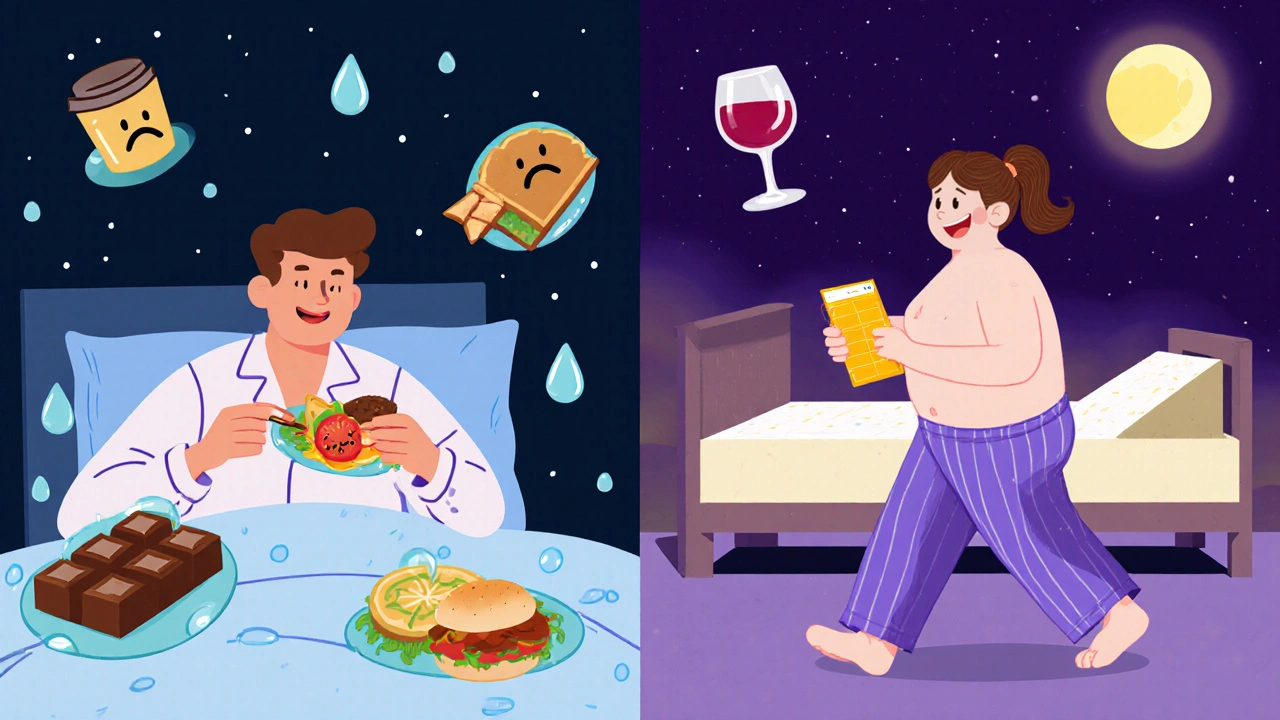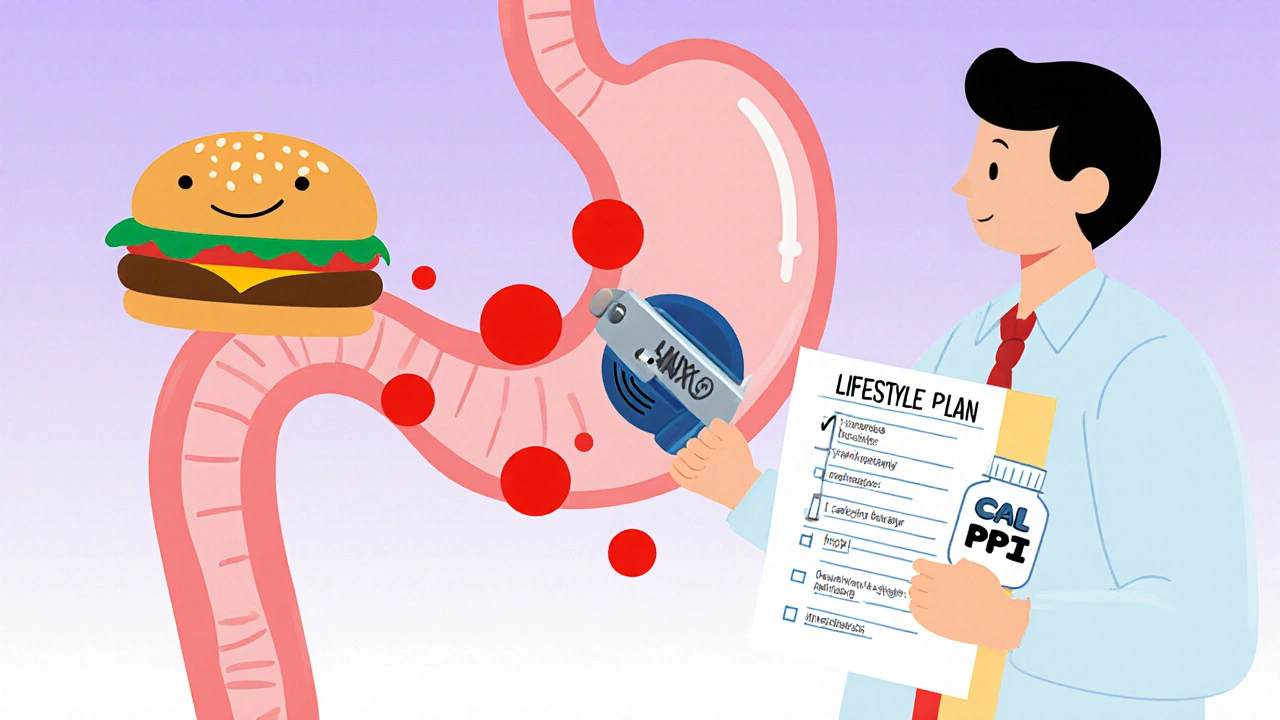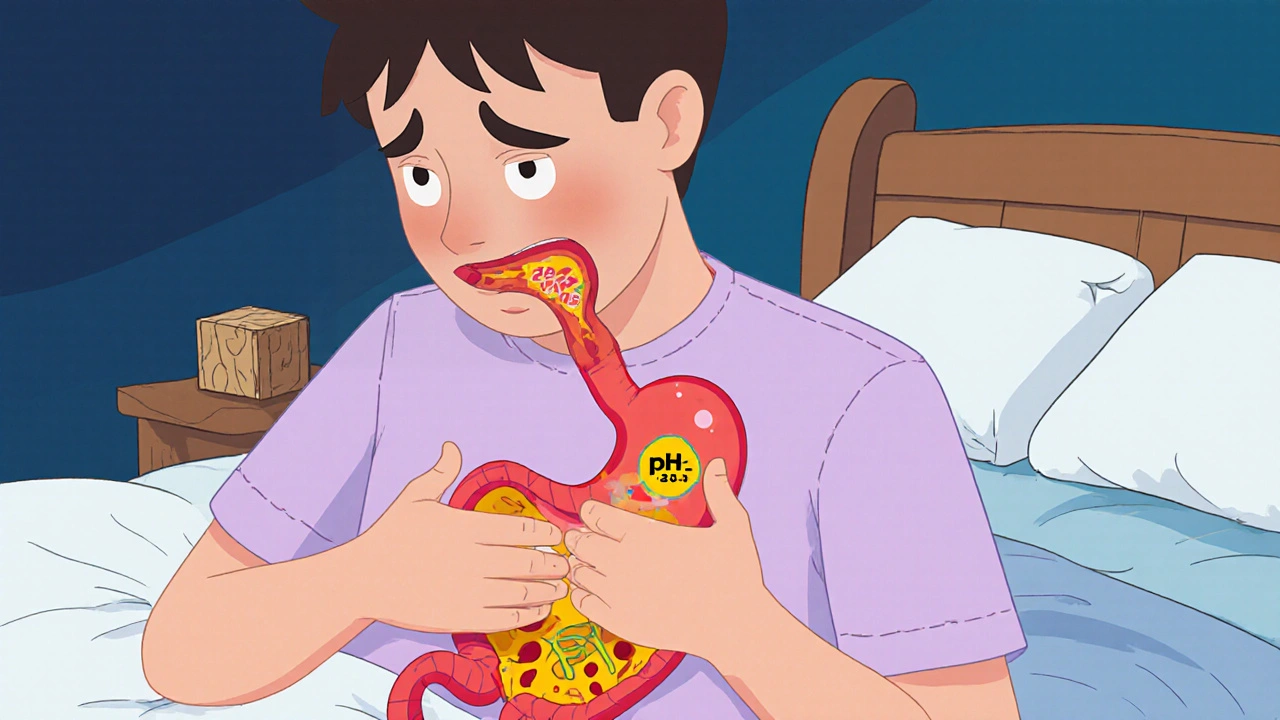Heartburn after pizza. Waking up with a sour taste in your mouth. A chronic cough that won’t go away. If this sounds familiar, you’re not alone. About 20% of adults in the U.S. deal with GERD symptoms at least once a week. For many, it starts as an occasional annoyance-but left unchecked, it can lead to serious problems like esophageal damage, Barrett’s esophagus, or even difficulty swallowing. The good news? Most people can take control of GERD with two powerful tools: lifestyle changes and the right use of medication.
What’s Really Happening When You Have Acid Reflux?
GERD isn’t just “bad heartburn.” It’s a chronic condition where the lower esophageal sphincter (LES)-a ring of muscle at the bottom of your esophagus-stops working right. Instead of staying tightly closed after food enters your stomach, it opens too easily or doesn’t close fully. That lets stomach acid, which has a pH between 1.5 and 3.5, splash back up into your esophagus. Your stomach lining can handle that acid. Your esophagus? Not so much.
That’s why you feel that burning sensation in your chest. It’s not your heart-it’s your esophagus being irritated. Around 90% of people with GERD report this classic symptom. Others get a sour or bitter taste in their mouth, a hoarse voice, or a cough that gets worse at night. Some even feel bloated or nauseous after meals. These aren’t just inconveniences. They’re signs your body is under stress from repeated acid exposure.
What makes it worse? Certain habits and body factors. Being overweight (especially with a BMI over 30) increases your risk by 2.5 times. Smoking cuts the LES’s ability to close by half. Pregnancy, hiatal hernias, and even some medications like calcium channel blockers can trigger or worsen reflux. And if you eat late, lie down soon after eating, or bend over after meals? You’re practically inviting acid to climb up.
Why Lifestyle Changes Are the First Step-Not Just a Suggestion
Doctors don’t just recommend lifestyle changes because they sound nice. They’re the most effective starting point-and for many, they’re enough.
Studies show that losing just 5-10% of your body weight can cut GERD symptoms in half. That’s not magic. Extra weight puts pressure on your stomach, pushing contents upward. Even a few pounds off can make a big difference.
Then there’s timing. Eating within two to three hours of bedtime means your stomach is still working when you lie down. Gravity stops helping you. Research shows cutting out late-night snacks reduces nighttime acid exposure by 40-60%. Simple? Yes. Easy? Not always. But it works.
Food triggers are personal-but some are almost universal. Coffee, tomatoes, alcohol, chocolate, fatty foods, and spicy dishes cause trouble for 70-80% of GERD patients. You don’t have to eliminate them forever. Try cutting them out for two weeks. Keep a food diary. Note what you eat and when symptoms hit. Then slowly bring things back one at a time. You might find you can tolerate a small glass of wine on weekends but not two. That’s the goal: personalization, not punishment.
Another simple trick? Elevate the head of your bed by 6-8 inches. Not just extra pillows-those can make things worse. Use blocks under the bed frame or a wedge pillow designed for reflux. This keeps acid where it belongs while you sleep.
How PPIs Work-and Why They’re So Common
If lifestyle changes alone don’t cut it, proton pump inhibitors (PPIs) are the next step. These include omeprazole (Prilosec), pantoprazole (Protonix), and esomeprazole (Nexium). They’re not antacids. They don’t neutralize acid. They shut it down at the source.
PPIs block the final step in acid production inside stomach cells. They reduce acid output by 90-98%. That’s why they heal esophagitis (inflammation of the esophagus) in 70-90% of cases-far better than H2 blockers like famotidine, which only cut acid by 60-70%.
They’re also fast-acting. Most people feel relief within a few days. But here’s the catch: they need to be taken correctly. Take them 30-60 minutes before your first meal of the day. That’s when your stomach starts turning on its acid pumps. If you take them after eating, they won’t work as well.
That’s why PPIs are prescribed in 70% of GERD cases. They’re powerful. They’re effective. And for many, they’re life-changing.

The Hidden Costs of Long-Term PPI Use
But PPIs aren’t harmless. Taking them for more than a year raises your risk of certain problems. Studies linked long-term use to a 20-50% higher chance of gut infections like C. diff, lower vitamin B12 levels, and kidney inflammation. For older adults on high doses for three or more years, hip fracture risk jumps by 35%.
And then there’s rebound acid hypersecretion. When you stop PPIs suddenly, your stomach overcompensates. Acid production surges. Symptoms come back harder than before. That’s why so many people feel stuck on them-even if they don’t need them anymore.
A 2021 study found that 44% of users who quit PPIs cold turkey experienced worse reflux than before. That’s not a side effect-it’s a physiological response. The solution? Don’t stop abruptly. Work with your doctor to taper off slowly, often using H2 blockers like famotidine as a bridge.
Here’s the reality: up to 70% of PPI prescriptions are unnecessary. People take them for heartburn that could be managed with diet, weight loss, or timing. Others stay on them years after symptoms disappeared. The American College of Gastroenterology says: reevaluate every 8 weeks. Can you lower the dose? Switch to on-demand use? Try an H2 blocker? That’s the standard.
When Lifestyle + PPIs Work Best Together
The best outcomes don’t come from choosing between lifestyle and medication. They come from combining them.
Take the case of a 55-year-old patient documented in a 2022 study. They were on PPIs daily for three years. Their symptoms improved-but they kept eating late and drinking wine. They developed Barrett’s esophagus, a precancerous condition. The PPIs masked the damage. The lifestyle habits kept it going.
Now compare that to a 2023 Johns Hopkins trial. Patients followed a 12-week program: weight loss, trigger food elimination, no eating after 7 p.m., and bed elevation. Half of them stopped PPIs entirely and stayed symptom-free. The other half cut their dose in half. Only 28% of those in standard care managed the same.
It’s not about perfection. It’s about consistency. You don’t have to give up every treat. But if you know coffee triggers your cough, skip it in the morning. If pizza gives you chest pain, save it for weekends-and don’t lie down after.

New Options Beyond PPIs
The landscape is changing. In 2023, the FDA approved Vonoprazan (Voquezna), the first new acid-blocking drug in 30 years. It works differently than PPIs-blocking acid more quickly and with less rebound. Early studies show 89% healing rates in erosive esophagitis, slightly better than PPIs.
For people who don’t respond to meds, newer procedures are available. The LINX® device is a tiny magnetic bracelet placed around the LES during minimally invasive surgery. It lets food pass but blocks reflux. Eighty-five percent of users report symptom reduction five years later. Another option, transoral incisionless fundoplication (TIF), rebuilds the valve from inside the stomach using an endoscope. Patients say it improves quality of life more than staying on PPIs.
And tech is helping. Apps like RefluxMD let you log meals, sleep, and symptoms. AI models are now predicting your personal triggers with 78% accuracy. Imagine knowing exactly which foods cause your reflux-without guessing.
When to See a Doctor (And What to Watch For)
Not every heartburn needs a doctor. But some signs do. If you have trouble swallowing, unexplained weight loss, vomiting blood, or black, tarry stools-get checked. These aren’t typical GERD symptoms. They could mean ulcers, strictures, or even esophageal cancer.
Even if you feel fine, if you’ve been on PPIs for more than a year without a review, schedule a check-in. Ask: “Can I reduce this?” “Do I still need it?” “Should I try lifestyle changes first?”
Most people can manage GERD without surgery. But you need a plan. Not just a pill.
Practical Steps to Start Today
- Stop eating 3 hours before bed. Set a phone reminder if you need to.
- Track your meals and symptoms for two weeks. Use a notebook or app like RefluxMD.
- Identify your top 3 trigger foods. Cut them out completely for 14 days.
- If you’re overweight, aim to lose 5-10% of your body weight. Even 10 pounds helps.
- If you’re on PPIs, ask your doctor if you can try taking them every other day or only when symptoms flare.
- Elevate your bed head by 6-8 inches. Use blocks, not just pillows.
GERD isn’t a life sentence. It’s a signal. Your body is telling you something’s out of balance. The solution isn’t always a pill. Sometimes, it’s a change in when you eat, what you eat, and how you live.
Can lifestyle changes cure GERD without medication?
Yes-for many people. Studies show that losing 5-10% of body weight and avoiding trigger foods can reduce symptoms by 50% or more. Some patients eliminate PPIs entirely after following a structured 12-week lifestyle program. But it depends on severity. If you have erosive esophagitis or severe symptoms, medication may still be needed initially. Lifestyle changes are the foundation, even when medication is part of the plan.
How long should I take PPIs for GERD?
Most guidelines recommend using PPIs for the shortest time possible. For mild GERD, try 4-8 weeks. If symptoms improve, work with your doctor to taper off. For chronic cases, reevaluate every 3-6 months. Long-term use (over 1 year) increases risks like infections, nutrient deficiencies, and bone fractures. Don’t stay on PPIs indefinitely unless your doctor confirms it’s necessary.
Why do I get worse reflux when I stop PPIs?
This is called rebound acid hypersecretion. PPIs suppress acid production so effectively that your stomach responds by making more acid-producing cells. When you stop suddenly, those cells go into overdrive. Symptoms return stronger for a few weeks. The fix? Don’t quit cold turkey. Gradually reduce the dose over 4-8 weeks, often using an H2 blocker like famotidine to bridge the gap.
Are there natural alternatives to PPIs?
There’s no proven natural replacement for PPIs when it comes to healing esophagitis. But lifestyle changes-weight loss, avoiding triggers, elevating your bed, and not eating late-work as well or better than many medications for mild to moderate GERD. Some people find relief with ginger tea or chewing gum after meals (it increases saliva, which neutralizes acid), but these are supports, not substitutes for medical treatment.
Can GERD lead to cancer?
Long-term, untreated GERD can lead to Barrett’s esophagus, a condition where the lining of the esophagus changes to resemble intestinal tissue. About 10-15% of people with chronic GERD develop this. Barrett’s esophagus slightly increases the risk of esophageal cancer, but the overall risk remains low-less than 0.5% per year. Regular monitoring with endoscopy is recommended for those with long-standing GERD or Barrett’s to catch changes early.
If you’ve been living with GERD for years, it’s easy to think it’s just part of life. But it doesn’t have to be. The right mix of smart habits and smart medication can give you back your sleep, your meals, and your peace of mind. Start small. Track your progress. And don’t be afraid to ask your doctor if you still need that daily pill.


David vaughan
I’ve been tracking my meals with RefluxMD for two weeks now… and holy crap, coffee at 7am = chest fire by 9am. I cut it out. No more burning. I didn’t even realize how bad it was until the app showed me the pattern. Also, elevating my bed with those blocks? Game. Changer. I actually slept through the night for the first time in years. 🙏
Florian Moser
This is exactly the kind of practical, science-backed advice we need more of. So many people think GERD is just ‘bad digestion’ and reach for Tums like candy. But it’s a systemic issue - and lifestyle tweaks? They’re not optional. They’re the foundation. Keep sharing this stuff. People need to hear it.
Franck Emma
I’ve been on PPIs for 7 years. I just stopped. Now I’m crying in the bathroom at 3am. This is hell.
Steve Harris
Hey, I get that rebound acid thing is real - I went through it too. But here’s the thing: I didn’t quit cold turkey. I dropped from once daily to every other day, then switched to famotidine on the off days for two weeks. Now I’m down to taking PPIs only when I eat pizza or drink wine. It’s not perfect, but I’m not trapped. You can do this. Slow and steady.
Paula Jane Butterfield
thank you for this post!! i’m a nurse and i see so many patients who’ve been on ppi’s for a decade and never thought to ask if they still needed them. one lady told me she took it because her mom did. i showed her the tapering guide and she cried. not from pain - from relief. you’re helping people.
Simone Wood
Let’s be real - the pharmaceutical industry loves PPIs. They’re cash cows. And the FDA? They’re slow. Vonoprazan got approved in 2023? That’s 30 years of stagnation. Meanwhile, Big Pharma keeps pushing the same pills while quietly burying the long-term risks. Wake up, people. This isn’t medicine - it’s a business model.
Leo Tamisch
So… lifestyle changes work? Wow. Mind blown. 🤯 I always thought science was about pills and procedures. Turns out, the ancient wisdom of ‘don’t eat before bed’ is more effective than a $200/month drug. I feel like I just discovered gravity.
Sheldon Bazinga
lmao so you're telling me i need to stop eating pizza and sleep with bricks under my bed? next you'll say i should stop watching youtube at 2am and drink water. what a joke. i'm 32 and my body is a temple. i dont need your 'science' to tell me how to live. #pillsareforweaklings
Logan Romine
Life is a paradox. We seek control through medication, yet the cure lies in surrendering to rhythm - sleep, eat, rest. PPIs are a Band-Aid on a broken spine. The real question isn’t ‘how to stop PPIs’… it’s ‘why did we let our lives become so disconnected from our biology?’ 🌿
Sandi Moon
Interesting. But have you considered that the rise in GERD correlates directly with the decline of traditional diets? In 1950, the average American consumed 12 pounds of sugar per year. Today? 150. The modern diet - processed, refined, and industrial - is the true culprit. PPIs are merely treating the symptom of a broken food system. The real solution? Return to whole foods. Or prepare for a future of pharmaceutical dependency.
Michael Marrale
Wait… so you’re saying the government and Big Pharma are hiding the truth about GERD? And that bed elevation is a conspiracy to make us buy special pillows? I’ve been researching this for 3 years - I know what’s really going on. The LES isn’t a muscle - it’s a bio-magnetic field controlled by 5G towers. That’s why the PPIs don’t work long-term. They’re designed to keep you dependent. I’ve built a Faraday cage for my bedroom. It’s working. So far.
Swati Jain
OMG I’m from India and we’ve been doing this for centuries - no PPIs needed. Eat light. No late dinners. Ginger + fennel after meals. Sleep on left side. Elevate head. Simple. Why did we forget this? Because we bought into the ‘magic pill’ lie. I’ve helped 3 friends quit PPIs using this. No drama. Just ancient wisdom + consistency. 🙏
Eliza Oakes
Okay but what if I’m just a coffee addict who loves pizza and refuses to sleep? Am I doomed? Is my esophagus just a sacrifice zone? Do I need to become a monk? Or is there a pill for being emotionally attached to my bad habits? 🤭
Cooper Long
The data presented is statistically robust and clinically significant. The integration of behavioral modification with pharmacological intervention represents the current gold standard in gastroesophageal management. However, longitudinal compliance remains the primary limiting factor in therapeutic success. A structured, patient-centered approach is imperative.